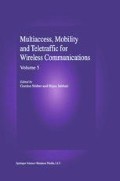Abstract
In this paper, we study the statistical characterization of the error process arising when data blocks are transmitted over a Wideband CDMA air interface, as currently being standardized for third generation wireless systems. The study includes propagation effects and multi-cellular operation, as well as several features of the proposed schemes, e.g., closed-loop power control. The simulation tools developed are briefly described, and some results are presented. Special focus is given to the relationship between the observed error behavior and some simple error models to be used in analytical studies.
Access this chapter
Tax calculation will be finalised at checkout
Purchases are for personal use only
Preview
Unable to display preview. Download preview PDF.
References
M. Zorzi, R.R. Rao, “The Role of Error Correlations in the Design of Protocols for Packet Switched Services,” in Proc. 35th Annual Allerton Conference, pp. 749–758, Sep. 1997.
M. Zorzi, R.R. Rao, “Perspectives on the Impact of Error Statistics on Protocols for Wireless Networks,” IEEE Personal Communications, vol. 6, Oct. 1999.
H. Balakrishnan, V.N. Padmanabhan, S. Seshan, and R.H. Katz, “A comparison of mechanisms for improving TCP performance over wireless links,” ACM/IEEE Trans. on Networking, Dec. 1997.
R. Ludwig et al.,“Multi-layer tracing of TCP over a reliable wireless link,” submitted to SIGMETRICS’99.
M. Zorzi, R.R. Rao, “On channel modeling for delay analysis of packet communications over wireless links,” in Proc. 36th Annual Allerton Conference, Sep. 1998
M. Zorzi, R.R. R.o, “Error Control and Energy Consumption in Communications for Nomadic Computing,” IEEE Trans. Computers (special issue on Mobile Computing), vol. 46, pp. 279–289, Mar. 1997.
M. Zorzi, R.R. Rao, “Energy constrained error control for wireless channels,” IEEE Personal Communications Magazine, vol. 4, pp. 27–33, Dec. 1997.
W. Turin, Digital transmission systems: performance analysis and modeling, Mc-Graw-Hill, 1998.
E.N. Gilbert, “Capacity of a burst-noise channel”, Bell System Tech. Journal, vol. 39, pp. 1253–1266, Sept. 1960.
M. Zorzi, R.R. Rao, L.B. Milstein, “On the accuracy of a first-order Markov model for data block transmission on fading channels,” in Proc. IEEE ICUPC’95, pp. 211–215, Nov. 1995.
E Swarts, H.C. Ferreira, “Markov characterization of channels with soft decision outputs,” IEEE Trans. Commun., vol. COM-41, pp. 678–682, May 1993.
H.S. Wang, N. Moayeri, “Finite-state Markov channel — a useful model for radio communication channels”, IEEE Trans. Veh. Technol., vol. VT-44, pp. 163–171, Feb. 1995.
W. Turin, R. Van Nobelen, “Hidden Markov modeling of fading channels:’ in Proc. VTC98, pp. 1234–38, May 1998.
Y. Y. Kim, S.Q. Li, “Modeling fast fading channel dynamics for packet data performance analysis:’ in Proc. INFOCOM98, pp. 1292–1300, Apr. 1998.
W. C. Jakes, Jr., Microwave mobile communications, New York: John Wiley and Sons, 1974.
ETSI SMG2, “Evaluation report for ETSI UMTS Terrestrial Radio Access (UTRA) ITU-R RTT Candidate:’ Sep. 1998 ( http://www.itu.intlimtl2-radio-dev/reports/etsi/eva_utra.pdf).
UMTS Technical Specifications, www.3gpp.org
A. Giovanardi et al.,“Some results on power control in Wideband CDMA cellular networks,” in Proc. WCNC2000,Sep. 2000.
V. Tralli, “Efficient Simulation of Frame and Bit Error Rate in Wireless Systems with Convolutional Codes and Correlated Fading Channels:’ in Proc. WCNC’99, Sep. 1999.
M. Zorzi et al.,“Some results on the error statistics over the UMTS air interface,” Internal Report, Università di Ferrara, Jan. 2000.
M. Zorzi, R.R. R.o, “Lateness probability of a retransmission scheme for error control on a two-state Markov channel,” IEEE Trans. Comm., vol. 47, Oct. 1999.
Author information
Authors and Affiliations
Editor information
Editors and Affiliations
Rights and permissions
Copyright information
© 2000 Springer Science+Business Media New York
About this chapter
Cite this chapter
Zorzi, M., Mazzini, G., Tralli, V., Giovanardi, A. (2000). On the Error Statistics over a WCDMA Air Interface. In: Stüber, G., Jabbari, B. (eds) Multiaccess, Mobility and Teletraffic in Wireless Communications: Volume 5. Springer, Boston, MA. https://doi.org/10.1007/978-1-4757-5916-7_14
Download citation
DOI: https://doi.org/10.1007/978-1-4757-5916-7_14
Publisher Name: Springer, Boston, MA
Print ISBN: 978-1-4419-4872-4
Online ISBN: 978-1-4757-5916-7
eBook Packages: Springer Book Archive

